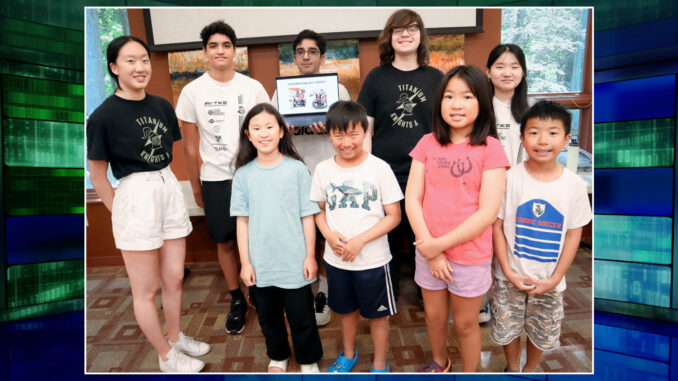
CLOSTER—This summer, the Closter Public Library became a gathering place for young tech standouts of all ages.
On Aug. 5, five members of the Titanium Knights Team 15891 presented about robots that they built for a regional and state competition called POWERPLAY.
The Titanium Knights is a robotics club at the Bergen County Academies — a public magnet high school in Hackensack. The members share a passion for STEAM (Science, Technology, Engineering, Arts, and Mathematics).
Team 15891, a merger of two previous teams, is made of dedicated students with different levels of experience in grades 9–12.
At their Closter Library presentation, Aubrey Shes, Mohit Kalin, Neil Dhalwann, Conner Landzettel and Juna Lee fascinated adults as well as children with their knowledge of robotics using demonstrations illustrated on laptop computers.
They showed how their robots can move in any direction, stand and sit, pick up and drop (traffic) cones and wave their arms around.
They explained how the team built their robots, a complicated process using metals, wheels, screws and wires.
“To make the robot obey commands, we created a hub for it by coding with a JAVA program associated with the competition,” Kallin said.
The presentation was followed by a flurry of questions.
“Are robots like AI?”, one woman asked.
Dhalwann: “To some extent yes.”
“Does a robot cost a lot of money to build?”
Molit: “Yes. Robots are very expensive, and we do this on our own, but we have some sponsorship from companies like Google.”
The Titanium Knights teams share the mission of creating a self-sustaining and student-run robotics team that educates and supports students both outside of and within the community.
For this year, the goal of the 15 member Team 15891 is to learn about robotics in a competitive environment through this year’s challenge, POWERPLAY.
Dhalwann said that their goal is to “Grow the team, recruit more members, and share our passion for robotics with more people, particularly younger generations, by participating in outreach that promotes robotics awareness.”
Conner, a sophomore, added, “The seniors mentor the younger classes so they can take over the team when they graduate.”
Team 15891 has been competing in the FIRST Tech Challenge for four seasons, and 26 official events since 2019.
The team has also engaged in outreach events in a number of locations, including American Dream and the Liberty Science Center.
Throughout July and August, the Closter Public Library also hosted a weekly robotics class for youngsters in elementary and middle school grades. Geared to each child’s expertise, there are different workshops in which children are free to choose whatever they want: Snap Circuits, WeDo Lego Education and Lego Mindstorms.
Snap Circuits introduces basic engineering, electronics and circuitry concepts by using building components with snaps to assemble electronic circuits on a simple “rows-and-columns” base grid.
The resulting projects are interactive and function like the printed circuit board found in most electronic products. When students connect the circuits correctly, they can power different objects, such as a motor, a fan, etc. The program ensures safety by using batteries, not live wires.
The WeDo 2.0 Core Set, also designed for primary school students, is a hands-on solution that enhances pupils’ curiosity and skills in computing, science and robotics. The set is delivered in a storage bin along with sorting trays, labels, a Smarthub (the “brain” of the computer), a Medium Motor, Motion Sensor, a Tilt Sensor, and building elements.
Lego Mindstorms is a hardware and software structure which develops programmable robots based on Lego building blocks. Each version includes an intelligent brick (or hub), a set of modular sensors and motors, and parts from the Lego Technic line to create the mechanical systems. The system is controlled by the intelligent brick, which act as the brain of the mechanical system and is activated by writing instructions in basic code on an app.
The library’s robotics program is so popular that it has been running four semesters throughout the year. It is directed by Lupita O’Brien, the library’s head of Youth Services.
“I love this program because it gives kids early exposure about the components of robotics, so when they get to high school, they are ready for it. They are actually studying what years ago would be advanced engineering.
The robotics program is led by a 16-year-old robotics enthusiast, Chloe Kim.
“When I was the age of these students, there really wasn’t a program like this, and it was really hard for me to find a good resource,” Kim said. “So, I wanted to create safe space where people can get a head start and learn coding.”
After a hiatus, Kim re-started the program several years ago and she helped obtain funding for it from The Friends of the Closter Public Library.
Robotic program sessions at the Closter Library summer often included as many as 22 children, so there are always several assistants on hand. Assisting Kim this summer were Julienne Lee and Dan and Ash Sabnani.
The Closter Library Robotics program motivates students so much that some of them go on to enroll in STEM programs at technical and engineering high schools, making it a really outstanding “live wire act.”
MORE PHOTOS: Read this feature via the free September 2023 issue of Northern Valley Press on PDF!
